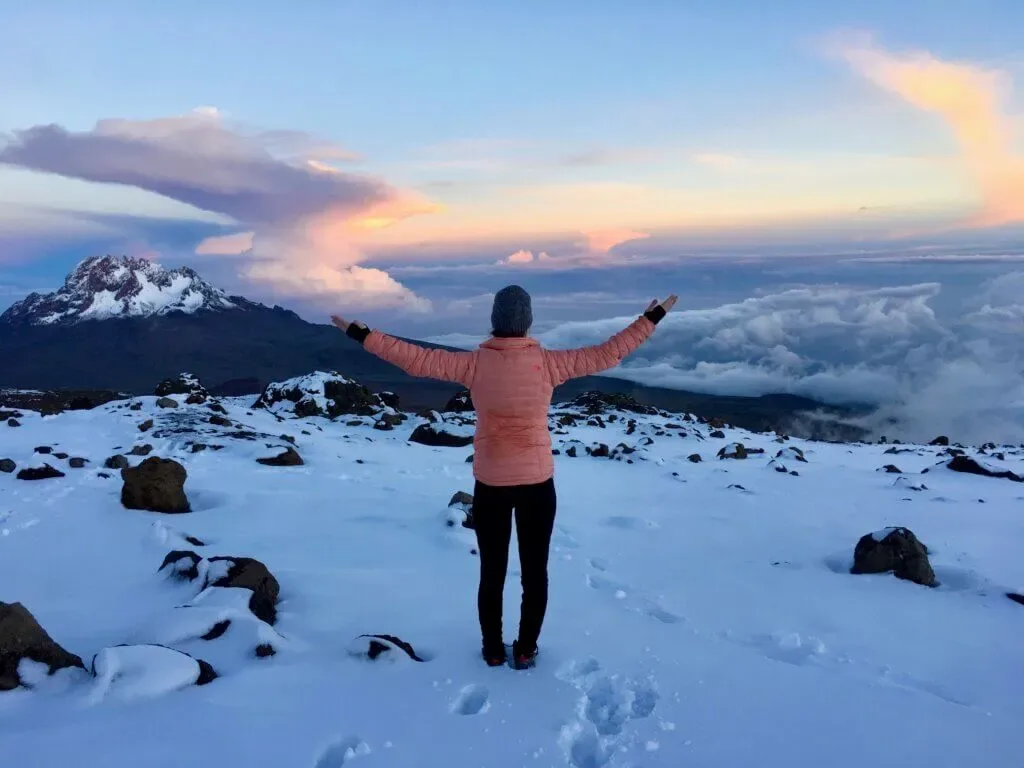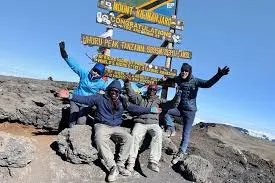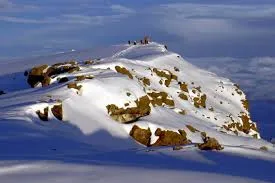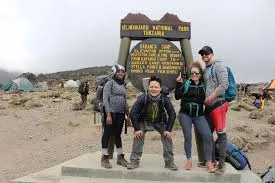Beginner’s Guide to Climbing Kilimanjaro
Climbing Kilimanjaro is a challenge, but it’s absolutely doable with the right preparation. Start by choosing a route that matches your fitness level and allows enough days for acclimatization longer routes increase your chances of success. Train with regular hikes and cardio workouts, and invest in proper gear, especially layered clothing and sturdy boots. Don’t underestimate the importance of hydration, pacing yourself slowly, and eating well on the mountain. Most importantly, go with a reputable operator who prioritizes safety. This comprehensive guide covers everything you need to know: choosing the best route, preparing physically and mentally, packing essentials, understanding costs, and avoiding common pitfalls. Whether you’re new to trekking or seeking an unforgettable adventure, our expert tips and 98% summit success rate ensure you’re ready to climb Kilimanjaro safely and successfully.
Start Your Kilimanjaro Adventure
Why Climb Kilimanjaro? A Beginner’s Adventure
Climbing Mount Kilimanjaro, which stands at 5,895 meters (19,341 feet), is an exciting adventure for both beginners and experienced hikers. As Africa’s tallest peak and one of the Seven Summits, Kilimanjaro combines challenge with accessibility. You don’t need technical climbing skills, making it perfect for first-time trekkers who are fit and determined. With Capable Africa Tours, you will explore diverse ecosystems, ranging from lush rainforests to arctic summits. You will be guided by experts who have a 98% summit success rate.
Key Highlights of Climbing Kilimanjaro
- Non-Technical Climb: Suitable for beginners with no prior climbing experience.
- Diverse Routes: Options like Marangu, Machame, and Lemosho cater to different fitness levels and schedules.
- Stunning Scenery: Trek through rainforests, moorlands, alpine deserts, and glaciers.
- Cultural Experience: Engage with Tanzania’s Chagga communities and local guides.
- Life-Changing Achievement: Reach Uhuru Peak for breathtaking views and personal triumph.
Choosing the Best Kilimanjaro Route for Beginners
Selecting the right route is critical for a successful Kilimanjaro climb, especially for beginners. Each route varies in duration, difficulty, scenery, and acclimatization opportunities. Below is a detailed comparison table of beginner-friendly routes offered by Capable Africa Tours.
| Route | Duration | Difficulty | Success Rate | Accommodation | Best For |
|---|---|---|---|---|---|
| Marangu Route | 5–6 days | Moderate | 60–70% | Huts | Beginners seeking comfort |
| Machame Route | 6–7 days | Challenging | 80–85% | Tents | Fit beginners wanting scenic views |
| Lemosho Route | 7–8 days | Challenging | 85–90% | Tents | Beginners prioritizing acclimatization |
| Rongai Route | 6–7 days | Moderate | 75–80% | Tents | Beginners seeking quieter trails |
Recommendation: For beginners, the 6-day Marangu Route offers hut-based accommodation and a moderate pace, while the 7-day Lemosho Route provides better acclimatization and stunning scenery. Capable Africa Tours customizes itineraries to match your fitness and goals.
How to Prepare for Kilimanjaro as a Beginner
Climbing Kilimanjaro requires physical, mental, and logistical preparation. Beginners should focus on building endurance, understanding altitude challenges, and packing appropriately. Here’s a step-by-step guide from Capable Africa Tours to get you summit-ready.
Physical Training (3–6 Months Before)
- Cardio Workouts: Run, cycle, or swim 3–4 times weekly (30–60 minutes) to build stamina.
- Hiking Practice: Train with 5–10kg daypacks on 4–8-hour hikes to simulate trekking conditions.
- Strength Training: Focus on legs, core, and upper body with squats, lunges, and planks (2–3 sessions weekly).
- Altitude Simulation: If possible, hike at higher elevations or use altitude training masks.
Mental Preparation
- Learn About Altitude: Understand symptoms of altitude sickness (headache, nausea) and coping strategies.
- Set Realistic Goals: Focus on enjoying the journey, not just reaching the summit.
- Join a Group: Capable Africa Tours’ group treks foster camaraderie and motivation.
Logistical Planning
- Book Early: Secure your spot with Capable Africa Tours 6–12 months in advance.
- Visas & Vaccinations: Obtain a Tanzanian visa and yellow fever vaccination.
- Travel Insurance: Choose a policy covering high-altitude trekking (up to 6,000m).
Essential Gear for Climbing Kilimanjaro
Packing the right gear is crucial for a safe and comfortable Kilimanjaro climb. Focus on lightweight, durable items to handle diverse climates and altitudes. Below is a detailed packing list tailored for beginners by Capable Africa Tours.
Clothing
- Base Layers: 3–4 moisture-wicking shirts and pants (merino wool, 200g) for sweat management.
- Mid-Layers: 2 fleece jackets (300–400g) for insulation in 40–60°F zones.
- Outer Layers: Waterproof, windproof jacket and pants (Gore-Tex) for rain and summit winds.
- Thermal Gear: 800-fill down jacket and thermal underwear for summit night (0–20°F).
- Accessories: 2–3 pairs wool socks, broken-in hiking boots, gaiters, gloves, and a warm hat.
- Sun Protection: UV400 sunglasses, wide-brimmed hat, and SPF 50+ sunscreen.
Equipment
- Daypack: 30–40L (5–7kg) for daily essentials like water and snacks.
- Duffel Bag: 70–90L waterproof bag (up to 15kg) for porters.
- Sleeping Bag: Rated for -15°C/5°F with a sleeping pad (R-value 4+).
- Trekking Poles: Adjustable, lightweight (500–700g) for stability.
- Headlamp: 200+ lumens with spare batteries for summit night.
- Water System: 3L hydration bladder or two 1L reusable bottles.
Personal Items
- First-Aid Kit: Bandages, blister pads, painkillers, and Diamox for altitude.
- Toiletries: Biodegradable soap, toothbrush, lip balm, and wet wipes.
- Documents: Passport, visa, insurance, and vaccination card.
- Electronics: 10,000mAh power bank and camera with spare batteries.
- Snacks: 500–1,000g of energy bars, nuts, or dried fruit.
Tip: Capable Africa Tours offers gear rentals (sleeping bags, trekking poles) to lighten your load. Contact us for details.
Cost of Climbing Kilimanjaro
The cost of climbing Kilimanjaro varies based on route, duration, and operator. On average, expect to spend $2,000–$4,000 for a 5–9-day trek, including park fees, guides, porters, meals, and accommodation. Capable Africa Tours offers all-inclusive packages with transparent pricing.
Cost Breakdown (Approximate)
| Expense | Cost Range (USD) |
|---|---|
| Park Fees | $800–$1,200 |
| Guides & Porters | $600–$1,000 |
| Accommodation & Meals | $400–$800 |
| Gear Rentals | $100–$300 |
| Transfers & Logistics | $200–$500 |
Tip: Choose longer routes like Lemosho for better value, as they increase summit success rates. Capable Africa Tours offers customizable packages to fit your budget.
Visualize Your Kilimanjaro Climb
Get inspired for your Kilimanjaro adventure with Capable Africa Tours. Watch this map to explore the routes and terrain you’ll conquer.
Top 10 Tips for Beginners Climbing Kilimanjaro
For first-time climbers, Mount Kilimanjaro can seem challenging, but with the right preparation and mindset, the trek is very achievable. Success largely depends on pacing yourself, choosing the right gear, and preparing both physically and mentally. Here are the top 10 tips to help beginners maximize their chances of a safe and successful climb with Capable Africa Tours.
- Choose the Right Route: Opt for Marangu or Lemosho for beginner-friendly pacing and acclimatization.
- Train Consistently: Build endurance with cardio and hiking 3–6 months before your trek.
- Pack Light: Stick to a 15kg duffel and 5–7kg daypack to stay comfortable.
- Acclimatize Properly: Select longer routes (7–8 days) to reduce altitude sickness risks.
- Stay Hydrated: Drink 3–4 liters of water daily to combat altitude effects.
- Pace Yourself: Follow the “pole pole” (slowly) mantra to conserve energy.
- Use Trekking Poles: Improve stability and reduce knee strain on descents.
- Protect Against Sun: Use SPF 50+ sunscreen and UV400 sunglasses at high altitudes.
- Listen to Guides: Capable Africa Tours’ experts monitor your health and pace.
- Bring Snacks: Pack high-energy snacks (500–1,000g) for quick boosts.
Ready to Conquer Kilimanjaro?
Embark on an unforgettable adventure with Capable Africa Tours. Our beginner-friendly Kilimanjaro treks include expert guides, all-inclusive packages, and a 98% summit success rate. Book now to secure your spot!
- Expert guides with 98% summit success rate
- Customizable routes for all fitness levels
- Eco-friendly treks supporting local communities
- Gear rentals for hassle-free preparation
- All-inclusive packages with meals and transfers
Limited spots available—start your Kilimanjaro journey today!
Book Your Trek Now


